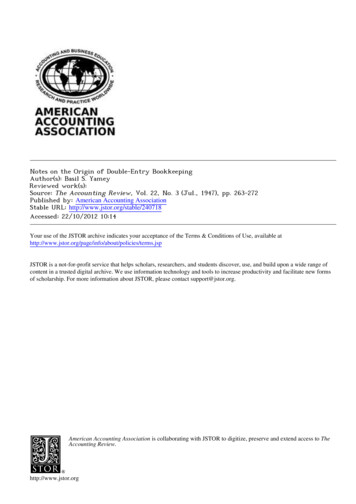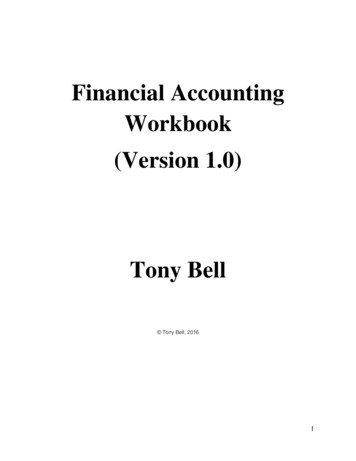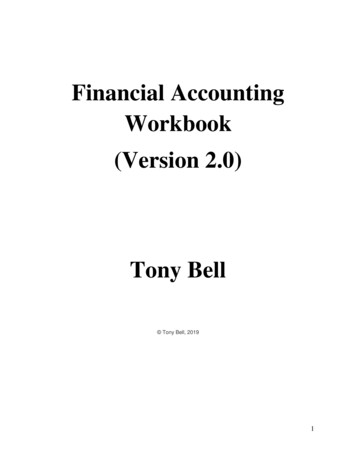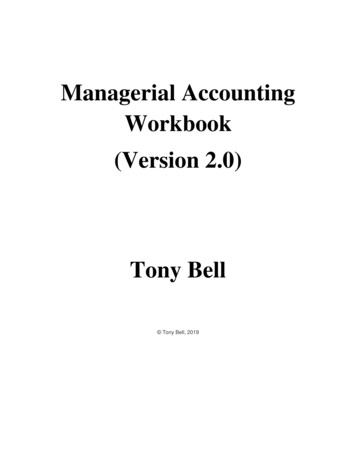
Transcription
Double Entry Accounting WorkbookErin Lawlor
Double Entry Accounting WorkbookTable of ContentsIntroductionFinancial Statement IntroductionFinancial TransactionsDebits and CreditsJournal EntriesChart of AccountsGeneral Ledger/T-AccountsTrial BalanceAccounting TypesOrder of LiquidityAccount NumbersFinancial StatementsIncome StatementsBreak-Even PointBalance Sheet*Bonus MaterialClosing Journal EntryGeneral Ledger ExamplesDepreciationCash Flow StatementSubledgersAccounts PayableAccounts ReceivableBank Reconciliation . 2 . 3 . 4 . 4 . 10 . 16 . 18 . 19 . 25 . 28 . 29 . 30 . 31 . 33 . 34 . 38 . 40 . 44 . 46 . 49 . 49 . 52 . 55*About me: I have been working in Accounting for 22 years, I have a BS degree in Accounting and have doneevery Accounting job I can think of from Accounts Payable to Controller of a Home Health Care Agency,Home Builder and a Commercial Construction Company. Currently I provide Accounting and AccountingSoftware support as a Consultant in Utah.*Disclaimer: The information in this book is written from my experience, research and training. I do not writewith authority from any Accounting Standards organization 2009 -2010 all rights reserved Erin Lawlor
Double Entry Accounting WorkbookIntroduction:The subject of this workbook is the Double Entry Accounting System. This system has been in usesince at least the 12th century and it continues to be the most effective financial accounting system today.Double Entry Accounting is surprisingly simple and is built around only a very few concepts, a balancebetween what a business has, where the business got what it has and how to organize the answers to thosequestions. With those few concepts, the Double Entry System successfully provides financial accounting forany size of business in any industry.This workbook is focused on the things you need to know before you use accounting software andbefore you read financial statements. It starts with the central system of accounting with the least amount ofdetail possible so that you can quickly understand the concepts. The main elements of the central system areDebits, Credits, Journal Entries, the General Ledger and Financial Statements. The Financial Statements andreports we cover are the Trial Balance, Income Statement and Balance Sheet.Performing accounting tasks and accessing accounting data has been made much more efficient bysoftware which is able to take advantage of the computer's ability to organize and compute large volumes ofdata. But despite claims made by some software companies, software can't do it all for you. Just like you needto understand your industry, you need to understand the basics of accounting in order to understand its reportsand statements.Accounting is about the destination, we gather the data so we can produce reports that tell us about ourcompanies. It is important to learn how accounting works and how your accounting software works but moveaway from the details of both as quickly as possible. Use your software and its reports to take a drill downapproach focusing first on summaries and then on details.Accounting reports are meant to keep you on track and to let you know when you need to make coursecorrections. Before we get into the process of gathering and organizing data, let's take a look at two financialstatements the Balance Sheet and Income Statement which we will create in this workbook. Examples of theBalance Sheet and Income Statement are on the next page.Financial Statements:The Balance Sheet is like the X on a map that says “You are Here”. It tells you what your business owns,what it owes and what it is worth (book value). Items listed on the Balance Sheet have lasting value and theyremain on the balance sheet until they are disposed of. Items that do not have lasting value are listed on theIncome Statement.The Income Statement calculates Net Income which is Sales Revenue - Expenses. The Income Statement givesa detailed explanation of how much money you earned and what your costs were. Items listed on the IncomeStatement do not have lasting value, they are used up within the current business year. Income Statementbalances do not carry forward the way Balance Sheet balances do, they are reset and started at zero again at thebeginning of each business year. The Income Statement also makes a distinction between the Direct Cost ofproducts and services and the Administrative Cost of running a business. Revenue – Direct Costs GrossMargin (Profit). Gross Margin – Administrative Costs (Expenses) Net Income.
Financial StatementsFormat and ContentsIncome StatementBalance SheetDecember 2010AssetsCurrent AssetsChecking AccountFixed AssetsOffice EquipmentComputer HardwareOffice FurnitureTotal Fixed AssetsTotal AssetsLiabilities and EquityCurrent LiabilitiesAccounts PayableTotal LiabilitiesDecember 31, 2010 550.00 225.00 900.00 945.00———— 2,070.00———— 2,620.00 680.00———— 680.00EquityOwners' EquityNet Income (Loss)Total EquityTotal Liabilities and Equity 2,600.00 (660.00)———— 1,940.00 2,620.00Advertising SalesWebsite HostingGross MarginOperating ExpensesRepairs & MaintenanceFuelRentOffice SuppliesSubscriptionsMealsPhone ServiceElectric ServiceBank ChargesCredit Card InterestTotal Operating ExpensesAssets What the Business Owns Liabilities What the Business Owes and must repay Where it cameEquity What the Business is Worthfrom(What the Business Owners have investedplus Business Net Income)Total Assets must equal Total Liabilities plus Equity 25.00 25.00 500.00 75.00 65.00 45.00 150.00 100.00 25.00 30.00Net Income(Loss) 1,040.00 (660.00)Income Statement FormatBalance Sheet FormatWhat we have 500.00 120.00 380.00 RevenueTotal Sales Amount- Cost of Goods Sold What it cost to purchaseand/or manufacture productsand/or provide services sold————— Gross MarginAmount of Revenue leftafter direct costs tocover operating expenses-Expenses —————Net Income(Loss)Operating Costs Consumed(No lasting Value)Profit(Loss) from salesafter all consumable costs.Represents the increase ordecrease, for the current year,in what the Business is worthThis look at the financial statements we will create is meant to give you a visual representation of where we'regoing as we progress through the process of gathering and organizing financial data. Let's dig into thegathering and organizing processes now starting with Section 1, Financial Transactions.
Section 1: Financial TransactionsPart 1: Learn to identify transaction elementsThe main objective of Double Entry Accounting is to create a balanced financial picture, that is, weshould not only know how money was used, we should also know where it came from. We achieve thisbalance in information through the way we record and organize financial transactions – so it is very importantto understand the elements of a financial transaction.Financial transactions are exchanges of things of value. In order to record a financial transaction, we need tobe able to answer these four questions.1.2.3.4.How was the money used? What was either acquired or paid for by this exchange?Where did the money come from? What is the source of the money in this exchange?What is the dollar value of the exchange?When? What is the date of the transaction?Questions 1 and 2 describe both sides of a transaction, what we did with the money and where the money camefrom. We cannot record transactions without answers to both of these questions.Example 1: Wrote a check for 100If you only have the information from Example 1 then you know the answers to Questions 2 and 3 but not toQuestion 1, what did you spend the 100 on? In order to record a transaction, you need the answer to Question1 as well. A better description would be:Example 2: Wrote a check for 100 for computer repairs.Example 2 has answered Questions 1, 2 and 3 but not Question 4. In accounting, dates are very important,dates are used to group financial activities together to help understand the profitability of a business and to helpin cash management. If I don't know the date of that 100 check, I won't know when it will be cashed and can'tmake sure there will be enough money in the bank to cover it.Example 3: Wrote check #999 dated March 1, 2009 for computer repairs.Example 3 provides the minimum data required for recording financial transactions. In a real situation, youwould also need to know what bank account the check was written from and who it was written to.Breaking Down Transaction Questions:To record financial transactions, we need to really understand the elements defined by the fourquestions. Let's start with some examples of scenarios and answers to the elements defined by Questions oneand two:1: How was the money used? What was either acquired or paid for in this exchange?2: Where did the money come from? What is the source of the money in this exchange?
For Example 3, the Answers to Question 1 and 2 are: 1: Computer Repairs2: Checking AccountIn this case, we took money from the Checking Account and used it to pay for Computer Repairs.The answers to Questions 1 and 2 are not always easy to identify so let's go through a brief explanation for theAcquisition/Use and Source elements of a transaction and then apply the explanations to a few scenarios.Question 1: Acquisition/Use - How was the money used? What was either acquired or paid for in thisexchange?Acquisition/Uses are: Expenses Increases in what you own Decreases in what you oweExpenses:Consumable item such as Rent, Phone Service, Food or Fuel. Those are short term acquisitions, whatyou've paid for is used up and may even be used up by the time they are paid for but while they lasted, theybelonged to you.Increases in what you Own:Increasing what you own is an acquisition: It is easy to identify the acquisition in things you own suchas Cash and Assets like Vehicles, Buildings and Equipment.Decreases in what you Owe:As I pay off something I owe, like a car loan, that is an acquisition because I have increased my ownclaim on that car, I own more of it and the bank owns less of it.Question 2: Source2: Where did the money come from? What is the source of the money in this exchange?Sources Are: Increases in Income Increases in what you Owe Decreases in what you OwnIncome:Income is the amount you charge in exchange for your products or services. When you receive apaycheck, the Paycheck is the Acquisition/Use and the Source is Income.Increases in What you Owe:Loans are temporary sources, meaning that eventually you will pay them back. Loans increase whenthey are Sources, and they decrease when they are Acquisitions/Uses.Investments into a business by its Owners are Sources. The business essentially owes its owners theamount they've invested. In the case of a cash investment, Cash is the Acquisition/Use and the Owner's
Investment (Equity) is the Source. Equity increases when it is a Source.Decreases in What you Own:The easiest Source to identify is Cash, we often use cash to pay for the things we buy. Using cash asthe Source actually causes a decrease in the things you own – in this case, a decrease in cash. Otherthings you own can also be used as a Source. If you trade one car for another, at least part of theSource in this case is your original Car.ScenariosLet's review the 2 transaction questions that we've covered so far:1: How was the money used? What was either acquired or paid for in this exchange?2: Where did the money come from? What is the source of the money in this exchange?Transaction Example: November 1, 2010 Paid 500 to landlord for Rent with Check #100 1: Acquisition/Use Rent2: Source Checking Account (Check/Cash)In this case, we took money from the Checking Account and used it to pay Rent.What if I didn't trade cash for rent, what if I traded accounting services with my landlord in exchange for rent? 1: Acquisition/Use Rent2: Source Accounting Services (Sales Income)In this case, the Acquisition/Use would still be Rent, I still had use of the space for the month, but thistime, instead of the Source being the Checking Account, the Source is Accounting Services (Income).Now lets say another tenant noticed the accounting services and asked me to do some accounting work for her.Let's say the agreement for this work is that she'll pay me in exchange for the work. 1: Acquisition/Use Checking Account (Check/Cash)2: Source Accounting Services (Sales/Income)In this case, we earned Money from the Accounting Services ProvidedLet's say that I used 1500 of my own money to open a new checking account for my business. 1: Acquisition/Use Checking Account2: Source Owner's Investment (Owner's Equity)In this case we're recording the Business's transactions, the Business acquired money in the checkingaccount and increased how much investment the owner has in the business.Identify the Use and the Source for each of these financial transactions.Table 1: Transactions 1 – 7 occur in November 2010Description1. Owner invested in the business and deposited 1500 intothe Business Checking AccountAcquisition/Use(Debit)Source (Credit)
DescriptionAcquisition/Use(Debit)Source (Credit)2. Paid Rent of 500 with Check #1003. Bought Office Phone/Fax for 75 with Check #1014. Used check #102 to buy new Printer for 1505. Bought 75 of Office Supplies with Check #1036. Bought 500 in parts for Server with Check #1047. Bank Charges of 10 deducted from Checking AccountAll of the transactions to this point have been cash transactions but a common event is to receive goods orservices “on account” or “on credit”. In that case, we record the receipt of goods and services when we arebilled for them.1. Receive the goods or services on account – no entry recorded2. Receive a bill for the goods or services – record receipt of Goods or Services and the Obligation to Pay(Accounts Payable). Acquisition/Use Goods or ServicesSource Accounts Payable3. Pay the bill – record Payment of Accounts Payable Acquisition/Use Accounts Payable (Decrease what I owe)Source Checking AccountSometimes, we are providing the goods or services on “account” or “credit”.1. Provide the goods or services on account – no entry recorded2. Send a bill for the goods or services – record the Sale of Goods or Services and record our customer'sObligation to Pay us (Accounts Receivable). Acquisition/Use Accounts ReceivableSource Sale/Income3. Receive payment for the bill – record Cash Receipt for Payment of Accounts Receivable Acquisition/Use Checking Account (Check/Cash)Source Accounts Receivable (decrease what I own)*Recording of Sales can be more complex than the scope of this workbook section, I discuss additional issuesinvolved including Inventory, Cost of Goods Sold and Revenue Recognition at the end of the workbook and onmy site http://www.accountingunplugged.com
Table 2: Transactions 8 – 16 of Table 2 occur in December 2010DescriptionAcquisition/Use8. Owner invested another 1100 and deposited it intoChecking Account9. Bought 700 Office Chair with Check #10510. Had car's Oil Changed for 25 – used Check #10611. Deposited 500 check for providing Advertising Space onsite into Checking Account12. Received 150 Phone Bill13. Received 100 Electric Bill14. Received Credit Card Statement 930 – additional entriesbelow (prior to #15): Credit Card Interest and Fees 30 Office Desk 245 Fuel 25 Business Magazines 65 Business Lunch 45 Website Hosting 120 Server Parts 40015. Paid 500 on Credit Card with Check #10716. Bank Charges of 15 deducted from Checking AccountAccounts PayableSource
Answers: Don't be concerned if your wording is a little different from mine as long as it is similar. Forexample, you might have used “cash” rather than “checking account”, or if you used “Income” rather than“Sales” don't worry we'll cover those issues as we continue through the workbook.Table 1: Transactions 1 – 7 occur in November 2010DescriptionAcquisition/UseSource1.Owner invested in the business and deposited 1500 into the Business Checking AccountChecking AccountOwner Investment2.Paid Rent of 500 with Check #100RentChecking Account3.Bought Office Phone/Fax for 75 with Check #101Phone/FaxChecking Account4.Used check #102 to buy new Printer for 150PrinterChecking Account5.Bought 75 of Office Supplies with Check #103Office SuppliesChecking Account6.Started building Server (Computer), bought 500 in parts with Check#104Server PartsChecking Account7.Bank Charges of 10 deducted from Checking AccountBank ChargesChecking AccountTable 2: Transactions 8 – 16 of Table 2 occur in December 2010DescriptionAcquisition/UseSource8.Owner invested another 1100 and deposited it into CheckingAccountChecking AccountOwner Investment9.Bought 700 Office Chair with Check #105Office ChairChecking AccountOil ChangeChecking Account10. Had car's Oil Changed for 25 – used Check #10611. Deposited 500 check for providing Advertising on site into Checking Checking AccountAccountAdvertising Income12. Received 150 Phone BillPhone ServiceAccounts Payable13. Received 100 Electric BillElectric ServiceAccounts Payable14. Received Credit Card Statement 930 – additional entries shown prior Credit Card Interest andto #15: Credit Card Interest and Fees 30FeesAccounts Payable Office Desk 245Office DeskAccounts Payable Fuel 25FuelAccounts Payable Business Magazines 65MagazinesAccounts Payable Business Lunch 45LunchAccounts Payable Website Hosting 120Internet ServiceAccounts Payable Server Parts 400Server PartsAccounts Payable15. Paid 500 on Credit Card with Check #107Accounts PayableChecking Account16. Bank Charges of 15 deducted from Checking AccountBank ChargesChecking Account
Section 1 Financial TransactionsPart 2 – Journal EntriesRecord Financial TransactionsWe've been using substituting “Acquisition/Use” for the Accounting term “Debit” and “Source” for theAccounting term “Credit”. Moving forward, we'll use the accounting terminology. Just remember that Debitalways means “Acquisition/Use” and Credit always means “Source”. No exceptions.Do not let your prior experiences with the terminology get your way when recording transactions. We areconditioned by banks to think that a debit to our bank account means that our bank account is decreasing andI've just told you that a debit is an Acquisition, that your bank account increases with a debit. The banks aren'twrong, they're just telling us how a debit affects their accounting, not ours. Essenti
The subject of this workbook is the Double Entry Accounting System. This system has been in use since at least the 12th century and it continues to be the most effective financial accounting system today. Double Entry Accounting is surprisingly simple and is built around only a very few concepts, a balanceFile Size: 415KB











